
The world of bonsai is a fascinating universe where art meets nature. Each bonsai is unique, reflecting not only the skill and vision of its creator, but also a wealth of styles and forms that captivate enthusiasts and connoisseurs. In this article, we explore the most popular and lesser-known styles of bonsai, a journey that can also be experienced through our Appy Bonsai app.
Exploring the different styles of bonsai is both an artistic and spiritual adventure. With our Appy Bonsai app, you can not only learn about these styles, but also receive personalized advice for growing and caring for your own bonsai. Join our community and start your journey into the captivating world of bonsai.
Bankan Style: The Spiral Bonsai
Definition and Origins
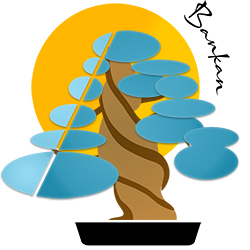
The Bankan style, also known as the "spiral style" or "tortuous style," is an artistic form of bonsai that represents resilience and perseverance in the face of natural challenges. This style captures the essence of a tree that has survived in harsh conditions, often marked by strong winds or hostile environments.
Distinctive Characteristics
- Twisted Trunk: The most notable feature of the Bankan style is its heavily twisted or spiral trunk, symbolizing the tree's struggle for survival.
- Dramatic Appearance: The twisted trunk creates a dramatic visual effect, giving the impression that the tree has been shaped by natural forces like wind or erosion.
- Adaptive Branching: The branches grow in an irregular manner, often extending in unpredictable directions, reflecting the tree's adaptation to its challenging environment.
- Textured Bark: The bark of these trees is often rough and crevassed, bearing witness to their age and struggle for survival.
- Exposed Roots: In some cases, the roots may be exposed, reinforcing the impression of struggle and resilience.
Species Selection
The Bankan style is suitable for tree species that naturally grow in a twisted manner or can be trained to develop spiral trunks. Species such as junipers, certain pines, and even hardwoods like maples can be styled in this manner.
Maintenance and Cultivation Techniques
- Wiring: The formation of the spiral trunk often requires the use of advanced wiring techniques, with special care to avoid damaging the bark.
- Pruning: Pruning is used to maintain and accentuate the irregular shape of the branches, contributing to the dramatic appearance of the whole.
- Protection: Given that this style evokes a struggle against the elements, it is crucial to protect the tree from extreme conditions that could cause real damage.
Conclusion
The Bankan style is a celebration of strength and endurance in the face of adversity. These bonsais are not just representations of natural resilience, but are also metaphors for life's ability to persevere and adapt. A Bankan bonsai is a living work of art, telling a story of survival and beauty born from struggle.
Bunjingi Style: The Scholar's Elegance in Bonsai
Definition and Origins

The Bunjingi style, also known as the "scholar's style" or "literati style," draws its inspiration from traditional Chinese painting, particularly the works of scholarly literati. This style is deeply rooted in the concepts of minimalism and elegance, reflecting the aesthetics and philosophy of ancient poets and artists.
Distinctive Characteristics
- Slim and Graceful Trunk: The trunk of a Bunjingi bonsai is typically long, slim, and graceful, rising with few or no branches until the crown. This trunk evokes the image of a tree growing in a confined space, struggling to reach the light.
- Limited Branching: Branching is often minimal, with a few thin and delicate branches, usually located near the top. These branches are arranged asymmetrically to create visual balance with the trunk.
- Airy and Poetic Appearance: The Bunjingi style favors an impression of airy elegance and simplicity. The tree appears as though swaying in the wind, evoking solitude and natural beauty.
- Modest Pot: The pots used for the Bunjingi style are often simple and undecorated, in keeping with the minimalism of the style.
- Calligraphy Influence: The appearance of the tree in this style is often compared to the fluid and expressive strokes of Asian calligraphy.
Species Selection
The Bunjingi style is particularly suitable for tree species with naturally thin and flexible trunks. Species such as pines, certain junipers, and maples can be adapted to this style.
Maintenance and Cultivation Techniques
- Pruning and Pinching: Pruning is used to maintain the minimalist structure of the tree, eliminating superfluous shoots and emphasizing the graceful shape of the trunk.
- Wiring: Although less common, wiring can be used to gently guide branches and the trunk into natural but artistic positions.
- Repotting and Substrate: A well-draining substrate is essential, as is periodic repotting to maintain the health of the tree.
Conclusion
The Bunjingi style embodies poetry and simplicity in the art of bonsai. These trees are not just a representation of nature, but also an expression of Eastern art and philosophy. A Bunjingi bonsai is a work that invites contemplation, reflecting subtle beauty and the balance between strength and flexibility.
Chokkan Style: The Art of Vertical Bonsai
Definition and Origins

The Chokkan style, also known as the "formal upright style," is one of the most traditional and respected forms in the art of bonsai. Originating from Japan, this style is an aesthetic representation of elegance and strength, evoking the image of a mature tree growing in an open environment without obstacles.
Distinctive Characteristics
- Straight and Strong Trunk: The most striking characteristic of the Chokkan style is its perfectly straight trunk, rising vertically from the base to the crown. This trunk serves as a solid and majestic backbone for the tree.
- Progressive Trunk Tapering: The trunk's diameter gradually decreases from the base to the top, creating a natural perspective and an illusion of height.
- Well-Developed Roots: The roots (Nebari) are well spread around the base, providing a solid anchorage and visual balance to the trunk.
- Symmetrical Branching: The branches are arranged symmetrically and balanced around the trunk, often in layers or tiers. The lowest branch (sashi-eda) is typically the longest, with increasingly shorter branches as one ascends.
- Conical Crown: The crown is conical and well-defined, tapering towards the top to complete the image of a mature tree.
Species Selection
The Chokkan style is particularly well-suited to tree species that naturally have a straight trunk and good branching capability. Typical examples include the Japanese Black Pine (Pinus thunbergii), various types of junipers, and the Japanese Maple (Acer palmatum).
Maintenance and Cultivation Techniques
- Pruning and Pinching: To maintain the conical shape and branch structure, regular pruning is essential. Pinching new shoots helps to encourage dense and controlled branching.
- Wiring: Although less frequent than in other styles, wiring can be used to adjust the angle and direction of branches.
- Repotting: Periodic repotting is crucial to maintain the health of the roots and the balance of the tree.
- Fertilization: Adequate fertilization is necessary to support the vigorous growth demanded by this style.
Conclusion
The Chokkan style, with its noble appearance and upright stature, is a classic symbol in the art of bonsai. Representing resilience, stability, and natural beauty, a Chokkan bonsai is much more than just a potted tree; it is a living work of art, reflecting the harmony and serenity of nature itself.
Fukinagashi Style: The Wind-Swept Bonsai
Definition and Origins
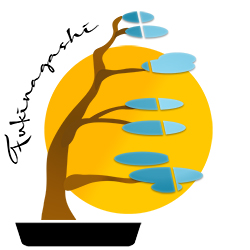
The Fukinagashi style, often referred to as the "wind-swept style," evokes the image of trees shaped by persistent winds in a natural environment. This bonsai style captures the essence of a tree struggling against powerful elements, a living representation of resistance and adaptation to the challenges of nature.
Distinctive Characteristics
- Leaning Trunk: The tree's trunk generally leans in one direction, as if constantly pushed by strong winds. This inclination can range from slight to extreme.
- Unilateral Branching: The branches primarily extend from one side of the tree, the side opposite the presumed wind. This gives the tree an unbalanced yet artistically harmonious appearance.
- Compact Foliage on the Windward Side: The foliage and branches on the windward side tend to be more compact and shorter, reinforcing the impression of exposure to powerful natural forces.
- Dynamic and Expressive Appearance: The Fukinagashi style is dynamic and full of movement. The tree appears in action, capturing a moment of ever-changing nature.
- Exposed and Strong Roots: The roots on the side opposite the inclination are often more exposed and developed, symbolizing the tree's anchoring against wind forces.
Species Selection
Species suited to the Fukinagashi style are those capable of developing flexible trunks and branches. Pines, junipers, and certain hardwoods like maples can be effectively styled in this manner.
Maintenance and Cultivation Techniques
- Pruning and Pinching: These techniques are used to maintain the asymmetrical shape and to encourage foliage density on the wind-exposed side.
- Wiring: Wiring may be necessary to direct the trunk and branches in the desired direction, simulating the effect of wind.
- Repotting and Substrate: As with all bonsais, a well-draining substrate and regular repotting are essential for the tree's health.
Conclusion
The Fukinagashi style is a celebration of strength and perseverance in the face of natural adversities. These bonsais represent not only beauty in resistance but also the poetry of movement and transformation. A Fukinagashi bonsai is a living work of art, telling a story of survival and adaptation against the indomitable forces of nature.
Han-Kengai Style: The Semi-Cascade Bonsai
Definition and Origins

The Han-Kengai style, known as the "semi-cascade," is a less extreme variant of the Kengai (cascade) style. This style represents trees growing on mountain slopes or along riversides, where they naturally lean downwards but do not hang as radically as in the full Kengai style.
Distinctive Characteristics
- Leaning and Branched Trunk: The trunk of the Han-Kengai bonsai leans or inclines downward, but with a less pronounced curvature than that observed in the Kengai style. The main trunk and branches may extend laterally or diagonally before descending.
- Balanced Branching: Branches are distributed evenly along the trunk, giving the tree a full and harmonious appearance. The upper branches are generally shorter, while the lower branches are longer and more extended.
- Airy Foliage: The foliage, typically denser at the top, gradually thins down along the trunk, balancing the overall appearance of the tree.
- Deep Pot: Han-Kengai trees are often planted in relatively deep pots, which provide adequate support while enhancing the hanging aesthetic of the tree.
- Natural and Fluid Appearance: The whole tree exudes a sense of natural and fluid movement, evoking the image of a tree leaning over a cliff or a watercourse.
Species Selection
Flexible and resilient species are well-suited to the Han-Kengai style. Junipers, certain pines, maples, and azaleas are among the popular choices for this style.
Maintenance and Cultivation Techniques
- Pruning and Pinching: These techniques are essential to maintain the tree's shape and to encourage dense branching, particularly in the upper part.
- Wiring: Wiring is often used to direct and maintain the shape of the trunk and main branches in the desired position.
- Repotting and Substrate: A well-draining substrate is crucial, as are periodic repotting to maintain the health of the tree.
Conclusion
The Han-Kengai style offers an elegant interpretation of natural trees growing in challenging conditions, yet retaining remarkable beauty and grace. With its semi-hanging form and balanced structure, a Han-Kengai bonsai is a living work of art, capturing the determination and adaptability of nature.
Hokidachi Style: The Broom-Style Bonsai
Definition and Origins

The Hokidachi style, also known as the "broom style," is one of the most recognizable bonsai styles. It mimics the appearance of mature deciduous trees with a round and uniform crown, reminiscent of a traditional broom. This style is typical of trees that grow in temperate climates with well-defined seasons.
Distinctive Characteristics
- Straight and Uniform Trunk: The trunk of the Hokidachi bonsai is straight and ends at a certain height where the crown begins. This trunk does not have significant branching.
- Round and Dense Crown: The most distinctive feature is its rounded and bushy crown, composed of many small branches emanating from the top of the trunk. This crown resembles a flared broom.
- Symmetrical and Radial Branching: The branches are arranged symmetrically and extend radially around the trunk, creating a dome or umbrella shape.
- Uniform Foliage: The leaves or needles are distributed evenly to give a full and balanced appearance to the crown.
- Simple and Basic Pot: The pots used for the Hokidachi style are generally simple and shallow, focusing attention on the tree rather than the container.
Species Selection
The Hokidachi style is ideal for fast-growing species with dense foliage, such as maples, beeches, and elms. These species easily create the characteristic rounded crown of this style.
Maintenance and Cultivation Techniques
- Pruning and Pinching: Regular pruning is essential to maintain the shape of the crown and encourage fine branching. Pinching helps control growth and densify the foliage.
- Wiring: Although less common, wiring can be used to direct branches during the early stages of formation.
- Repotting and Substrate: Regular repotting is necessary to maintain the health of the tree. A well-draining substrate promotes healthy root growth.
Conclusion
The Hokidachi style is emblematic of serenity and balance in the art of bonsai. It evokes the simple and natural beauty of deciduous trees. A Hokidachi bonsai is a soothing and harmonious spectacle, representing symmetry and order in the natural world.
Ikadabuki Style: The Raft-Style Bonsai
Definition and Origins

The Ikadabuki style, or "raft style," is a unique form of bonsai that mimics the appearance of a group of trees growing from a horizontally lying trunk. This form is often observed in nature when trees fall to the ground, their branches rising up to become individual trunks. The term "ikadabuki" refers to a floating raft, reflecting the horizontal alignment of the trunks and branches.
Distinctive Characteristics
- Horizontal Trunk: The Ikadabuki style is characterized by a main trunk lying horizontally, from which several vertical trunks emerge.
- Multiple Vertical Trunks: These vertical trunks, which were initially branches, represent individual trees. They are generally of varying sizes to create an impression of depth and naturalness.
- Visible Roots: Roots emerge from the lying trunk and penetrate into the soil, giving the impression that each vertical trunk is a separate tree.
- Dense and Balanced Foliage: The vertical trunks bear dense foliage, contributing to the illusion of a miniature forest.
- Long and Low Pot: The Ikadabuki style is often presented in an elongated pot, suited to the horizontal layout of the trunk.
Species Selection
Fast-growing and heavily branching species, such as junipers, pines, and certain types of maples, are well suited to the Ikadabuki style. These species allow for efficient formation of multiple trunks from branches.
Maintenance and Cultivation Techniques
- Pruning and Pinching: Regular pruning is necessary to maintain the shape of the vertical trunks and to encourage dense and balanced branching.
- Wiring: Wiring can be used to initially direct the branches upward, transforming them into vertical trunks.
- Repotting and Substrate: Repotting should be done carefully to not disturb the arrangement of roots and trunks. A well-draining substrate is essential.
Conclusion
The Ikadabuki style is a fascinating and creative representation in the art of bonsai, offering a miniature interpretation of a natural forest scene. This style is particularly appreciated for its ability to tell a story of survival and regeneration, symbolizing the resilience and continuity of life.
Ishitzuki Style: The Rock-Clasping Bonsai
Definition and Origins
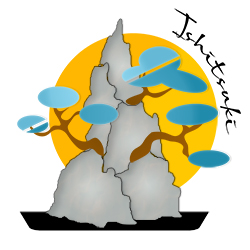
The Ishitzuki style, or "rock-clasping style," is a form of bonsai that features trees growing on or around rocks, mimicking natural trees that find their way through cracks and crevices of rocks and cliffs. This style symbolizes the coexistence and harmony between inert stone and plant life.
Distinctive Characteristics
- Integration with Stone: The stone or rock is a central element of this style. The tree appears to emerge directly from the rock, with its roots wrapping around or penetrating into the stone's crevices.
- Visible Roots: The tree's roots are often visible as they adapt to the rock's surface, seeking soil for anchorage and nutrition.
- Balance and Interaction: The Ishitzuki style focuses on the relationship between the tree and the rock, creating a visual balance between the two elements.
- Adaptive Foliage: The tree's foliage is generally adapted to highlight the stone, often draping over or around the rock.
- Pot and Presentation: The pot used in this style is often discreet and undersized to emphasize the rock and tree, rather than the container itself.
Species Selection
Species suited to the Ishitzuki style are those that can tolerate growth with restricted roots and can adapt to challenging growing conditions. Junipers, pines, and certain types of hardwoods are popular choices for this style.
Maintenance and Cultivation Techniques
- Watering and Nutrition: Watering must be managed carefully, as roots in contact with the rock can dry out quickly. Regular fertilization is also necessary to compensate for the limited amount of substrate available for the roots.
- Pruning and Pinching: These techniques are used to maintain the aesthetic balance between the tree and the rock, as well as to control the size and shape of the foliage.
- Root Protection: Roots extending over the rock may require additional protection during extreme seasons to prevent dehydration or frost damage.
Conclusion
The Ishitzuki style is a celebration of perseverance and adaptability in the art of bonsai. It represents the fascinating interaction between the plant kingdom and the mineral world, offering a miniature representation of a captivating natural phenomenon. This style is admired for its ability to portray resilience and beauty in challenging conditions.
Kabudachi Style: The Multi-Trunk Bonsai
Definition and Origins

The Kabudachi style, also known as the "multi-trunk style" or "clump style," represents a group of trees sharing the same root base. This style evokes the image of a miniature forest or a group of trees growing naturally very close to each other.
Distinctive Characteristics
- Several Trunks Sharing a Common Base: The Kabudachi style is characterized by several trunks emerging from a common root or a very close base in the soil. These trunks can vary in size and height, adding to the visual diversity.
- Harmony and Balance: Although each trunk is individual, together they form a harmonious composition. The balance between the trunks is essential for a natural look.
- Densely Branched Foliage: Each trunk carries its own foliage, creating a dense and unified canopy. The foliage is often trimmed to maintain the proportional scale of the miniature forest.
- Variation in Height and Diameter: The trunks differ in height and thickness, with a main trunk usually taller and thicker than the others.
- Wide and Shallow Pot: The Kabudachi style is typically presented in a wide and shallow pot, to accommodate the multiple trunks and to enhance the group aspect.
Species Selection
Species suited to the Kabudachi style are those that can naturally produce multiple trunks or can be trained to develop them. Maples, junipers, and elms are often used for this style.
Maintenance and Cultivation Techniques
- Pruning and Pinching: These techniques are important for maintaining the shape of each trunk and for encouraging dense and uniform branching.
- Repotting and Substrate: A well-draining substrate is crucial, as is regular repotting to ensure the health of the common roots.
- Watering and Fertilization: Special attention must be given to watering and fertilization, given the presence of several trunks sharing the same resources.
Conclusion
The Kabudachi style offers a captivating vision of nature in miniature, symbolizing coexistence and interdependence. This style is particularly appreciated for its ability to recreate the ambiance of a forest or grove, offering a complex and harmonious natural scene.
Kengai Style: The Cascade Bonsai
Definition and Origins

The Kengai style, or "cascade style," is a form of bonsai that imitates natural trees growing on steep slopes or cliffs, where branches and the trunk fall in a cascade due to gravity and environmental conditions. This style evokes the beauty and grace of trees struggling to survive in extreme conditions.
Distinctive Characteristics
- Cascading Trunk and Branches: The tree's trunk leans markedly downward, often beyond the edge of the pot, with branches following the same descending trajectory.
- Visual Balance: Despite its inclined form, the tree must maintain visual balance, with a sturdy trunk and well-distributed branches that extend horizontally and vertically.
- Deep Pot and Stability: The Kengai style is often planted in deep pots to allow for the natural fall of the trunk and branches while maintaining the balance and stability of the whole.
- Densely Branched Foliage: The cascading branches bear dense foliage, which contributes to the overall aesthetic of the tree and enhances the illusion of a waterfall or cascade.
- Dramatic and Graceful Appearance: The Kengai style is known for its dramatic and graceful appearance, evoking the challenges and resilience of nature.
Species Selection
Flexible species that are resistant to difficult conditions are preferred for the Kengai style. Junipers, pines, and certain hardwood species like maples are often used in this style.
Maintenance and Cultivation Techniques
- Pruning and Pinching: Pruning is crucial to maintain the cascade shape and to encourage branching. Pinching helps to control growth and densify the foliage.
- Wiring: Wiring is often used to direct the trunk and branches into the desired cascade form.
- Repotting and Substrate: Regular repotting with a well-draining substrate is necessary to maintain the tree's health.
Conclusion
The Kengai style is a poetic and artistic representation of strength and perseverance in the natural world. These cascading bonsais offer a visual interpretation of beauty that can emerge in difficult conditions, symbolizing the balance between grace and survival.
Moyogi Style: The Informal Upright Bonsai with a Curved Trunk
Definition and Origins

The Moyogi style, also known as the "informal upright style," is a form of bonsai that combines natural and artistic elements to create an appearance that is both organic and aesthetically pleasing. This style represents trees that grow in natural conditions with curves and movements in the trunk, while maintaining an overall vertical structure.
Distinctive Characteristics
- Curved Trunk: The defining characteristic of the Moyogi style is its curved or sinuous trunk. Unlike the Chokkan style, where the trunk is completely straight, the Moyogi features a trunk with natural and elegant curves.
- Balance and Movement: The trunk must show a sense of balance and movement, with curves that guide the eye through the structure of the tree.
- Harmonious Branching: The branches extend in a balanced manner from each side of the trunk, with a regular distribution to avoid overloading one side.
- Conical Crown: The tree's crown is conical, gradually tapering towards the top, and aligned with the base of the trunk to maintain visual balance.
- Pot and Presentation: The Moyogi style is often planted in relatively shallow pots that complement the natural shape of the tree without detracting from it.
Species Selection
The Moyogi style is suitable for many bonsai species, including pines, junipers, maples, and azaleas. These species are capable of developing trunks with interesting curves while maintaining good branching.
Maintenance and Cultivation Techniques
- Pruning and Pinching: Regular pruning is necessary to maintain the structure and shape of the trunk and branches. Pinching helps control growth and densify the foliage.
- Wiring: Wiring can be used to gently guide the trunk and branches into the desired curves, especially in the early stages of formation.
- Repotting and Substrate: Periodic repotting with a well-draining substrate is crucial for the overall health of the tree.
Conclusion
The Moyogi style is an example of the balance between natural form and the art of bonsai. It presents a mix of grace and structure, capturing the essence of a tree that has grown with a degree of freedom but has been carefully trained to create a living work of art.
Neagari Style: The Bonsai with Exposed Roots
Definition and Origins
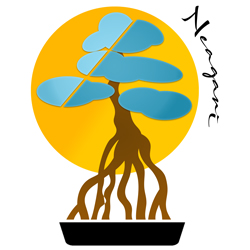
The Neagari style, known as the "exposed roots style," is a unique form of bonsai characterized by its exposed roots that seem to support the tree above the ground. This style imitates natural trees growing in conditions where the soil around their bases is eroded, leaving the roots visible and aerial.
Distinctive Characteristics
- Exposed and Elongated Roots: The main characteristic of the Neagari style is the presence of long and visible roots extending from the bottom of the trunk to the pot, creating an effect of natural columns or pillars.
- Elevated Trunk: Above these aerial roots, the trunk stands, often straight or slightly curved, giving an impression of height and elegance.
- Balanced Branching: Branches are distributed in a balanced manner around the trunk, in harmony with the vertical structure created by the roots.
- Proportionate Foliage: The foliage is proportionate to the height of the tree and the length of the roots, offering a visual balance between the aerial and root parts of the tree.
- Deep Pot and Support: Neagari trees are often planted in deeper pots to support the length of the aerial roots and to provide adequate anchorage.
Species Selection
Species with strong and flexible roots are ideal for the Neagari style. Bonsais such as junipers, certain pines, and even tropical species can be formed in this style.
Maintenance and Cultivation Techniques
- Root Care: Aerial roots require special attention to prevent drying out. They may need more frequent watering and protection from extreme elements.
- Pruning and Pinching: These techniques are used to maintain the shape and density of the foliage, in balance with the exposed roots.
- Wiring: Can be used to direct branches and enhance the overall appearance of the tree.
- Repotting and Substrate: A well-draining substrate is crucial, and repotting must be done carefully to not damage the exposed roots.
Conclusion
The Neagari style is fascinating and artistically stimulating, offering a unique representation of tree survival and adaptation in nature. These bonsais captivate with their mix of ruggedness and delicacy, evoking the wonders of natural growth and perseverance.
Nejikan Style: The Twisted Trunk Bonsai
Definition and Origins
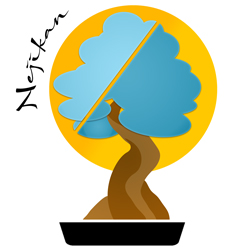
The Nejikan style, also known as the "twisted trunk style," is characterized by a trunk that naturally twists and turns, either naturally or through training. This style captures the aspect of trees that have twisted and coiled around themselves over time, often in response to environmental conditions like prevailing winds.
Distinctive Characteristics
- Twisted Trunk: The most striking feature of the Nejikan style is its distinctively twisted trunk, creating a unique and dynamic visual aspect.
- Natural and Graceful Movement: The trunk of the Nejikan bonsai coils in a natural and elegant manner, evoking a sense of movement and fluidity.
- Balanced Branching: Branches emanate from the twisted trunk, often asymmetrically, to complement and balance the twisted form of the trunk.
- Adaptive Foliage: The foliage is carefully maintained to complement and enhance the twisted shape of the trunk, without overburdening the tree.
- Pot and Presentation: The pot chosen for the Nejikan style is generally simple and understated, so as not to distract from the impressive appearance of the trunk.
Species Selection
Flexible and malleable species are most suitable for the Nejikan style. Junipers, certain types of pines, and maples are often used to create this captivating style.
Maintenance and Cultivation Techniques
- Pruning and Pinching: These techniques are essential to maintain the visual balance of the tree, particularly pruning to control growth and foliage density.
- Wiring: Wiring may be necessary to encourage or maintain the twist of the trunk and to direct the branches.
- Repotting and Substrate: Regular repotting with a well-draining substrate is important, taking care not to disturb the unique structure of the trunk.
Conclusion
The Nejikan style is a remarkable artistic expression in the world of bonsai, illustrating the beauty and intrigue of natural twisted forms. These trees offer a captivating perspective on strength and flexibility, telling a story of survival and adaptation through their spiral trunk.
Sabamiki Style: The Hollow-Trunk Bonsai
Definition and Origins
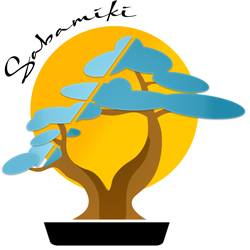
The Sabamiki style, or "hollow-trunk style," represents a unique and artistic aspect in the art of bonsai. This style mimics the appearance of ancient or damaged trees that have been affected by natural elements, such as lightning or rot, leaving cavities or hollows in the trunk.
Distinctive Characteristics
- Hollowed or Carved Trunk: The main feature of the Sabamiki style is the hollowed, carved, or split trunk, giving the impression of a tree that has survived significant damage.
- Aged and Survivor Appearance: The Sabamiki style evokes a sense of resilience and antiquity, illustrating the tree's ability to survive and thrive despite injuries.
- Natural Branching: Branches emerge from the damaged trunk naturally, often with denser growth around the healthy parts of the trunk.
- Trunk Texture and Color: The texture of the hollowed trunk is often rough and irregular, with varied colors to accentuate the hollows and cavities.
- Pot and Presentation: The pot for a Sabamiki bonsai is generally chosen to complement the robust and aged appearance of the tree, often with earthy or neutral tones.
Species Selection
Species with robust and thick trunks, such as pines, oaks, and maples, are well-suited for the Sabamiki style. These trees can withstand trunk hollowing without compromising their overall health.
Maintenance and Cultivation Techniques
- Creation and Maintenance of the Hollowed Trunk: Creating a Sabamiki trunk may require advanced techniques, including hollowing and carving of the trunk. Maintaining the health of the tree around the damaged area is crucial.
- Pruning and Pinching: Pruning is used to maintain the visual balance of the tree and to encourage harmonious branching around the hollowed parts.
- Repotting and Substrate: A well-draining substrate is important, as are regular repottings to ensure the health of the tree despite the hollowed trunk.
Conclusion
The Sabamiki style is a dramatic and expressive representation in the art of bonsai, capturing the essence of survival and perseverance. These trees offer a window into time and natural challenges, showing how beauty and strength can emerge from trials.
Sankan Style: The Three-Trunk Bonsai
Definition and Origins

The Sankan style, also known as the "three-trunk style," is a specific form of bonsai that features three distinct trunks emerging from a single root base or very close to each other in the soil. This style evokes the image of a small group of closely related trees, creating a natural and harmonious scene.
Distinctive Characteristics
- Three Trunks of Varying Heights: In the Sankan style, the three trunks generally vary in height, with one larger main trunk and two smaller secondary trunks, creating an interesting visual dynamic.
- Common Root Base or Proximity: The three trunks share a common root base or emerge from very close points in the soil, emphasizing their interconnectedness.
- Natural Balance and Harmony: The arrangement of the trunks aims to create a sense of harmony and natural balance, reflecting the appearance of small groups of trees in nature.
- Cohesive Branching: The branching of each trunk contributes to the overall canopy, creating a cohesive and integrated whole.
- Appropriate Pot: The pot for a Sankan bonsai is chosen to complement the composition of the three trunks, often wide enough to accommodate their arrangement.
Species Selection
Species suited to the Sankan style are those that can naturally produce multiple trunks or can be encouraged to do so. Maples, pines, and azaleas are often used for this style.
Maintenance and Cultivation Techniques
- Pruning and Pinching: Pruning is essential to maintain the visual balance between the three trunks and to encourage dense and uniform branching.
- Wiring: Wiring may be necessary to direct the branches of the trunks in order to maintain the harmony and balance of the composition.
- Repotting and Substrate: A well-draining substrate is crucial, as are regular repottings to maintain the health of the common root base.
Conclusion
The Sankan style offers a miniature and artistic interpretation of a small group of trees, capturing the essence of coexistence and harmony in nature. This style is appreciated for its balance and representation of a natural community in miniature.
Sekijoju Style: The Root-Over-Rock Bonsai
Definition and Origins

The Sekijoju style, also known as the "root-over-rock style," is a form of bonsai where the tree's roots wrap around and extend over a rock before reaching the soil of the pot. This style evokes trees growing on rocks or cliffs, with their roots adapting to the terrain in search of soil for nourishment.
Distinctive Characteristics
- Interlaced Roots on Rock: In the Sekijoju style, the tree's roots intricately intertwine around a rock, forming an impressive visual tableau.
- Interaction Between Roots and Rock: There is a fascinating interaction between the tree's roots and the rock, with the roots adapting to the contours and crevices of the rock.
- Balanced Trunk and Foliage: Above the roots, the trunk rises, often straight or slightly inclined, with balanced foliage that complements the whole.
- Natural and Artistic Appearance: The Sekijoju style offers a balance between art and nature, capturing the adaptability of trees in challenging conditions.
- Pot and Presentation: The pot for a Sekijoju bonsai is often simple and understated, allowing the roots and rock to stand out as focal points of the composition.
Species Selection
Species suitable for the Sekijoju style are those whose roots can adapt to growing on a rock, such as junipers, certain pines, and various hardwoods.
Maintenance and Cultivation Techniques
- Root Hydration: The exposed roots require special attention to ensure they receive enough moisture, especially those extending far from the tree's base.
- Pruning and Pinching: These techniques are used to maintain the shape of the trunk and foliage in harmony with the sinuous roots.
- Root Protection: The roots may need additional protection, particularly in extreme climates, to prevent drying out or freezing.
- Repotting and Substrate: A well-draining substrate is essential, as are regular repottings to ensure the overall health of the tree.
Conclusion
The Sekijoju style is a poetic representation of perseverance and adaptability in the world of bonsai. It shows how life finds a way even in the most inhospitable environments, offering a captivating scene of survival and natural beauty.
Shakan Style: The Slanting Trunk Bonsai
Definition and Origins
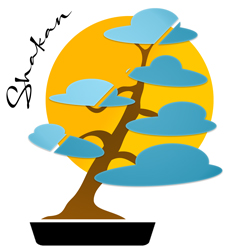
The Shakan style, or "slanting trunk style," is a form of bonsai where the tree is intentionally cultivated with a trunk that inclines at a significant angle from the vertical. This style evokes the image of trees facing challenging environmental conditions such as strong winds or steep slopes, forcing them to grow at an oblique angle.
Distinctive Characteristics
- Obliquely Inclined Trunk: The most characteristic trait of the Shakan style is its inclined trunk, which can vary from slightly to strongly inclined, but always with a clear and controlled intention.
- Balance and Stability: Despite the inclination of the trunk, the tree must maintain visual and physical balance, with solid rooting to prevent it from toppling over.
- Adaptive Branching: The branches are arranged to counterbalance the trunk's inclination, often more developed on the side opposite the inclination to maintain balance.
- Crown Aligned with the Base: The tree's crown is generally aligned with the base of the trunk, even if the trunk itself is inclined, for a harmonious aesthetic effect.
- Pot and Presentation: The pot chosen for a Shakan bonsai is often wider on one side to support the angle of the trunk and contribute to the overall balance of the composition.
Species Selection
Species with flexible and resilient trunks are preferred for the Shakan style. Pines, junipers, and certain types of hardwoods like maples are commonly used in this style.
Maintenance and Cultivation Techniques
- Pruning and Pinching: Pruning is essential to control growth and maintain the visual balance of the tree, especially for the branches on the inclined side.
- Wiring: Wiring can be used to direct the trunk and branches into the desired slanted position.
- Repotting and Substrate: A well-draining substrate is crucial, as are regular repottings to maintain the health and stability of the tree.
Conclusion
The Shakan style is a captivating manifestation of adaptation and resilience in the art of bonsai. It symbolizes the struggle of trees against environmental challenges, while offering a natural and dynamic aesthetic that stimulates the eye and the imagination.
Sharimiki Style: The Driftwood Bonsai
Definition and Origins

The Sharimiki style, also known as the "driftwood style," is an artistic form of bonsai that highlights the coexistence of living and dead wood on the same tree. This style represents the struggle and survival of trees in harsh environmental conditions, where part of the trunk is dead (often due to injuries, extreme weather conditions, or age), while the rest of the tree continues to grow.
Distinctive Characteristics
- Coexistence of Dead and Living Wood: The main characteristic of the Sharimiki style is the presence of dead wood (Shari) on the trunk, alongside or intertwined with living wood. This juxtaposition creates a striking visual contrast.
- Eroded and Sculpted Trunk: The trunk shows signs of erosion and natural sculpting, with parts of dead wood that may be bleached and eroded, contrasting with healthy bark.
- Balanced Branching and Foliage: Despite areas of dead wood, the tree has well-developed living branches and dense foliage, often emanating directly from the living parts of the trunk.
- Dramatic and Artistic Appearance: The Sharimiki style is renowned for its dramatic and artistic appearance, evoking themes of struggle, survival, and beauty in adversity.
- Pot and Presentation: The pot for a Sharimiki bonsai is often chosen to complement the dramatic nature of the tree, with colors and textures that enhance the dead wood.
Species Selection
Robust species resistant to extreme conditions are preferred for the Sharimiki style. Junipers, pines, and certain hardwoods are commonly used for their ability to survive with parts of dead wood.
Maintenance and Cultivation Techniques
- Dead Wood Treatment: Creating and maintaining dead wood requires specific techniques, such as scraping, bleaching, and preservation to prevent rot.
- Pruning and Pinching: Regular pruning is necessary to maintain the shape of the living branches and healthy foliage, while preserving the visual balance with the dead parts.
- Repotting and Substrate: A well-draining substrate is crucial, as are regular repottings to maintain the health of the living parts of the tree.
Conclusion
The Sharimiki style is a poignant expression of perseverance and endurance in the art of bonsai. It captures the beauty that emerges from struggle and trials, offering a symbolic representation of resilience in the face of life's challenges.
Sokan Style: The Double-Trunk Bonsai
Definition and Origins
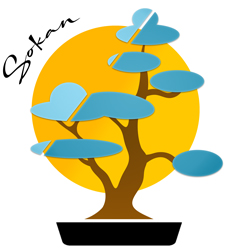
The Sokan style, also known as the "double-trunk style," is a form of bonsai characterized by two trunks emerging from the same root base or very close to each other in the soil. This style reflects the natural aspect of trees which, in nature, may develop two main trunks from a single root system, often in response to environmental conditions or damage at a young age.
Distinctive Characteristics
- Two Trunks of Different Sizes: The Sokan style features two distinct trunks, one usually larger and thicker (the main trunk) and the other smaller (the secondary trunk).
- Common Root Base: The two trunks share a common root base or emerge from very close points in the soil, creating an impression of a close relationship.
- Balance and Harmony: Although of different sizes, the trunks are arranged to create a balanced and harmonious composition, reflecting natural aesthetics.
- Branching and Foliage: Each trunk develops its own structure of branches and foliage, contributing to the overall canopy of the tree.
- Pot and Presentation: The pot chosen for a Sokan bonsai is often wide enough to accommodate both trunks and enhance the natural aspect of the composition.
Species Selection
Species capable of developing multiple trunks from a common base are ideal for the Sokan style. Maples, pines, and azaleas are popular choices for this style.
Maintenance and Cultivation Techniques
- Pruning and Pinching: Pruning is crucial to maintain the shape and balance of the two trunks, as well as to encourage proper branching.
- Wiring: Wiring may be necessary to direct branches and help form the structure of each trunk.
- Repotting and Substrate: A well-draining substrate is important for root health. Regular repotting is necessary to maintain the tree's vigor.
Conclusion
The Sokan style offers a natural and artistic representation of coexistence and interdependence. It symbolizes union and strength, capturing the essence of two living beings sharing a common base and growing together in harmony.
Takozukuri Style: The Raft Style Bonsai
Definition and Origins
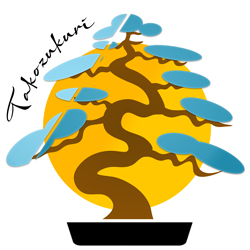
The Takozukuri style, known as the "raft style" in English, is a unique form of bonsai that mimics the appearance of naturally fallen trees that continue to grow horizontally, with new branches rising vertically from the lying trunk. This style evokes the image of trees toppled by wind or erosion, but persisting to live and develop in a horizontal orientation.
Distinctive Characteristics
- Horizontal Trunk: The trunk of the Takozukuri bonsai is positioned horizontally or nearly horizontally in the pot, imitating a fallen tree.
- Vertical Branches: Branches develop along the lying trunk, growing vertically or obliquely upwards, forming new miniature "trees."
- Roots and New Shoots: Branches emerging from the horizontal trunk often develop their own roots where they touch the soil, creating the illusion of a series of interconnected trees.
- Balance and Realism: The style aims to create a natural and realistic balance, with a branch arrangement that reflects how a fallen tree might regrow in nature.
- Pot and Presentation: The pot for a Takozukuri bonsai is usually long and shallow, providing enough space for the horizontal trunk and emerging branches.
Species Selection
Species with flexible trunks and vigorous growth, capable of producing aerial roots or offshoots from the trunk, are ideal for the Takozukuri style. Junipers, elms, and certain pines are frequently used.
Maintenance and Cultivation Techniques
- Pruning and Pinching: Pruning is essential to maintain the shape of the vertical branches and to encourage balanced growth along the lying trunk.
- Wiring: Wiring can be used to delicately position the emerging branches and to help form their structure.
- Repotting and Substrate: A well-draining substrate is important, as are periodic repottings to support the health of the extended tree.
Conclusion
The Takozukuri style is a captivating interpretation of resilience and adaptation in nature. It represents a tree's ability to persevere and adapt to new orientations after disruptive events, offering a unique perspective on strength and flexibility in the natural world.
Yose-ue Style: The Forest or Group Style Bonsai
Definition and Origins

The Yose-ue style, also known as the "forest style" or "group style," is a form of bonsai that represents a small group or forest of trees. In this style, multiple trees of the same species are planted together in a single pot, creating the illusion of a miniature forest. This style mimics the natural appearance of forests, with a variety of tree sizes and shapes contributing to an overall harmonious scene.
Distinctive Characteristics
- Multiple Trees: The main characteristic of the Yose-ue style is the presence of multiple trees planted together, usually of the same species, with variations in size and shape.
- Natural Arrangement: The trees are arranged in a way that mimics a natural forest, with one or more dominant trees (usually the largest or thickest) and other smaller trees distributed asymmetrically.
- Balance and Depth: The placement of trees aims to create visual balance and an impression of depth, with smaller or younger trees placed at the back or on the sides.
- Cohesive Branching: Although each tree has its own branching structure, together they should form a cohesive and unified canopy.
- Wide and Flat Pot: The pot for a Yose-ue bonsai is generally wide and relatively flat, providing enough space to accommodate the group of trees.
Species Selection
Species that can coexist closely and have similar growth patterns are ideal for the Yose-ue style. Maples, pines, and junipers are popular choices for creating forest compositions.
Maintenance and Cultivation Techniques
- Pruning and Pinching: Pruning is essential to maintain the shape of each individual tree and to preserve the overall balance of the forest.
- Wiring: Wiring can be used to direct the growth of branches and to help create a realistic forest scene.
- Repotting and Substrate: A well-draining substrate is crucial. Repotting should be done carefully so as not to disturb the arrangement of trees.
Conclusion
The Yose-ue style is a beautiful representation of collective beauty and harmony in nature. It offers a unique perspective on the interaction and interdependence of trees in a forest, capturing the essence of a miniature ecosystem.

















